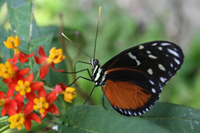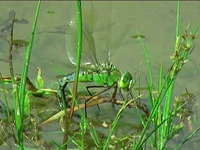 vid005 vid005
|
Emperor Dragonflies, Female laying eggs. All the time I was filming, the Mail was flying around me, he did not like the fact I was there.They frequently fly high up into the sky in search of prey, which includes butterflies, Four-spotted Chasers and tadpoles; small prey is eaten while flying. They breed in a variety of aquatic habitats from large ponds to dykes, but they require a plentiful supply of vegetation in the water. The females lay the eggs into plants such as pondweed, and always lay alone. But in this case she was laying in a rain water puddle at Penlee point nature walk area .
|
|
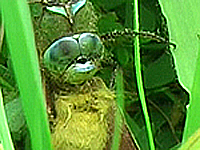 vid006 vid006 |
Emperor Dragonflies, Male eating an Oak Eager Moth.
While filming the Female I noticed the male had headed up into the sky about 40 feet to grab what I thought was a butterfly, But it turned out to be a Oak Eager Moth. The male is highly territorial, and difficult to approach. In the summer months Emperor dragonflies are often frequent visitors to gardens,.
|
|
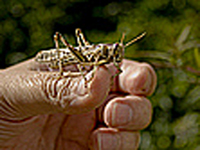 vid008 vid008 |
Desert Locust Schistocerca gregaria. Males are 40-50 mm, females are 50-60 mm long.
The desert locust is potentially the most dangerous of the locust pests because of the ability of swarms to fly rapidly across great distances. It has two to five generations per year. During quiet periods, called recessions, desert locusts are confined to a 16-million-square-kilometer belt that extends from Mauritania through the Sahara Desert in northern Africa, across the Arabian Peninsula, and into northwest India. Under optimal ecological and climatic conditions, several successive generations can occur, causing swarms to form and invade countries on all sides of the recession area, as far north as Spain and Russia, as far south as Nigeria and Kenya, and as far east as India and southwest Asia. As many as 60 countries can be affected within an area of 32 million square kilometers, or approximately 20 percent of the Earth's land surface. |
|
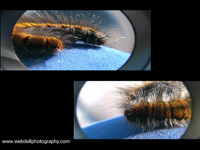 vid007 vid007 |
Fox Moth, Scientific name: Macrothylacia rubi
Size: Wingspan from 60 to 70mm Distribution: Found in most parts of the UK. Months seen: May to early July Food: Caterpillars feed on bramble and heather Habitat: Meadows, heathland, downland, open woods, parks and gardens.
The caterpillars can be a little tricky to identify as they change colour as they grow. The younger caterpillars are black with thin orange bands along their length. The older caterpillars are a reddish-brown colour and covered in long gray hairs. They can be found from June to April, but between the months of September and March they hibernate in leaf litter |
|
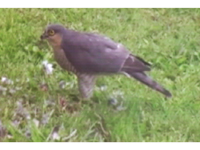 vid017 vid017 |
The Eurasian sparrowhawk (Accipiter nisus), also known as the northern sparrowhawk or simply the sparrowhawk, is a small bird of prey in the family Accipitridae. Adult male Eurasian sparrowhawks have bluish grey upperparts and orange-barred underparts; females and juveniles are brown above with brown barring below. The female is up to 25% larger than the male – one of the largest differences between the sexes in any bird species. Though it is a predator which specialises in catching woodland birds, the Eurasian sparrowhawk can be found in any habitat and often hunts garden birds in towns and cities. Males tend to take smaller birds, including tits, finches, and sparrows; females catch primarily thrushes and starlings, in this case a Pigeon. but are capable of killing birds weighing 500 g (18 oz) or more. |
|
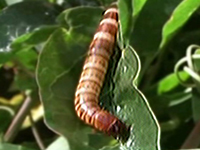 vid011 vid011 |
Mario worm (super mealworm) Zophobas morio.
Is a species of darkling beetle, whose larvae are known by the common name superworm or zophobas. Superworms are common in the reptile pet industry, not to be confused with giant mealworms, which are Tenebrio molitor larvae sprayed with juvenile hormone. These insect larvae resemble very large mealworms, about 1.7 to 2¼ inches long (50-60 mm) when full size. They have 6 small legs and two rudimentary hind prolegs. Once they reach adult size, the larvae pupate, and later emerge as large, black beetles. Superworms are accepted by lizards, turtles, frogs, salamanders, birds, koi and other insectivorous animals. Their hard chitin may make them less suitable for arachnids and some predatory insects. Their tendency to bite may make them unsuitable for some insectivorous mammals, such as hedgehogs. Their nutritional values are similar to those of mealworms. |
|
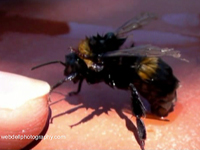 vid004 vid004 |
Buff-tailed bumblebee (Bombus terrestris)
Many bumblebees are social insects that form colonies with a single queen. The colonies are smaller than those of honeybees, growing to as few as 50 individuals in a nest. Female bumblebees can sting repeatedly, but generally ignore humans and other animals. Cuckoo bumblebees do not make nests; their queens aggressively invade the nests of other bumblebee species, kill the resident queens and then lay their own eggs, which are cared for by the resident workers. This is the tale of one who fell in the swimming pool, I helped him to get dry,then let him fly away
|
|
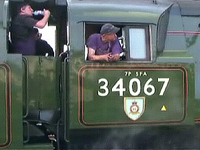 vid018 vid018 |
Tangmere 34067 at Plymouth Station, and Speeding through Newton Abbot
The SR West Country and Battle of Britain classes, collectively known as Light Pacifics. They were designed to be lighter in weight than their sister locomotives, the Merchant Navy class. To permit use on a wider variety of routes, including in the south-west of England and the Kent coast. A total of 110 locomotives were constructed between 1945 and 1950. sixty locomotives were rebuilt by British Railways during the late 1950s. This produced a design highly similar to the rebuilt Merchant Navy class. The classes operated until July 1967, when the last steam locomotives on the Southern Region were withdrawn. Although most were scrapped, twenty locomotives found new homes on heritage railways in Britain.
|
|
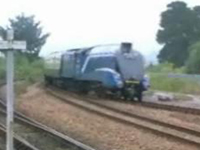 vid002 vid002 |
Bittern 4464 60019, slowly through Newton Abbot
4464 Bittern is a London & North Eastern Railway Class A4 steam locomotive. Built for the LNER in 1937 at Doncaster Works as works number 1866, it was originally numbered 4464. It was renumbered 19 on 16 August 1946 under the LNER 1946 renumbering scheme and after nationalisation in 1948, was renumbered 60019 by British Railways on 10 October 1948. It is a Pacific 4-6-2 locomotive to the same design by Nigel Gresley as the more famous A4 Mallard and one of the 35 strong class. It is one of six to survive into preservation and is one of three currently certified for mainline use. In preservation, the locomotive has also worn the identities of a number of its scrapped classmates, including the first of the A4 class 2509 Silver Link and most recently as 4492 Dominion of New Zealand.
|
|
 vid003 vid003 |
Britannia 70000 speeding through St Germans.
Britannia was built at Crewe, completed on 2 January 1951. She was the first British Railways standard locomotive to be built and the first of 55 locomotives of the Britannia class. The locomotive was named at a ceremony at Marylebone Station by the then Minister for Transport Alfred Barnes on 30 January 1951. Initially destined for the National Railway Museum because of her cultural significance, she was stored. However, due to her prototype design and construction differences, the NRM chose standard sister 70013 Oliver Cromwell, instead. Britannia was eventually bought by Britannia Locomotive Company Ltd. After a series of moves, she was eventually returned to steam on the Severn Valley Railway, where she remained for a number of years in operational but non-mainline condition. With the society wishing to make more use of the locomotive, she was moved to the European gauge Nene Valley Railway in Peterborough, where she was also fitted with an air-brake compressor, and was based there from 1980-2000. Britannia made her return to the main line on 27 July 1991, successfully working enthusiast trips until 1997, and was featured in an episode of London's Burning.
|
|
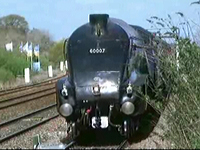 vid016 vid016 |
Sir Nigel Gresley 4478 60007 at Dawlish Warren
As with the other members of the 35-strong class, Sir Nigel Gresley wore many liveries throughout its career. It was released to traffic on 30 October 1937 in the standard LNER garter blue of the A4 Pacifics. Sir Nigel Gresley was repainted into wartime black with LNER markings on 21 February 1942. The next repaint was into black with NE markings on 20 October 1943, as a cutback. After the war, Sir Nigel Gresley regained LNER garter blue livery with red/white lining on 6 March 1947. With the formation of British Railways came new liveries and Sir Nigel Gresley was painted into British Railways dark blue with black and white lining on 27 September 1950. The final livery change was into British Railways brunswick green livery on 17 April 1952. In preservation, Sir Nigel Gresley wore garter blue (with stainless steel letters and numbers as 4498 added later) from 1966 until its overhaul in the late 1990s, when it gained its current British Railways blue livery as 60007. This livery was retained again after the 2006 overhaul.
|
|
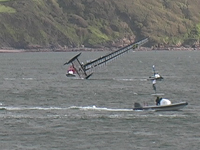 vid001 vid001 |
America's Cup Plymouth, UK - September 10-18, 2011 The Swedish Boat has a misshape on smashing Sunday !
America's Cup yacht racing brought in £9.1m for Plymouth's economy, according to a report. The Devon city hosted the world series event for nine days in September 2011 at a cost to the council of £225,000. An independent report said visitors spent £4.1m, the economic impact from increased business among hotels and local suppliers was £1.6m and media coverage was worth £4.2m. The council described the event as a "huge success".
One of the most costly sporting competitions in the world has just dropped anchor in Plymouth. Nine wing-sailed carbon-fibre catamarans costing £800,000 each are moored next to a tented village at Millbay in the city's docklands ready for the America's Cup World Series. see youtube https://youtu.be/Jvk4D-GlUgE |
|
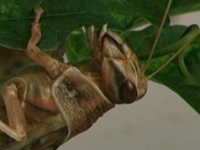 vid009 vid009 |
Desert Locust Schistocerca gregaria part 2 I have been fascinated about there eating process, how the fingers / tentacles manipulate there food and how it is bought to there mouth. I have not seen anything like it on wild life documentaries, so I thought I would attempt it myself. Although I am under operational constraints, Equipment is very limited. using only a standard lens from 5-6 feet away and zooming in as best as possible.
I used a White tent 1 meter cubed set up in my studio. Fed the locusts when first placed in the tent, then waited for 5 days and then fed them Passion flower leaves. |
|
| |
|
|
| |
|
|
| |
|
|
 |
Go to the next page for Youtube video's, which has some of my favourites places that other people have videoed. |
|


